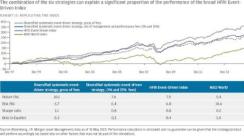Hedge funds are finding it hard to demonstrate value for money to increasingly cost-conscious investors. The funds haven’t been spared from the beta-driven revolution making waves across traditional long-only markets, as investors can now harvest a significant portion of hedge fund returns in an efficient, low-cost manner. One might intuit that the rise of so-called alternative beta strategies only serves to undercut actively managed hedge funds. In fact, we at J.P. Morgan Asset Management argue that the emergence of a better understanding of the sources of return in hedge funds not only has profound implications for asset allocators but also may actually help defend the role of skills-based managers who can consistently capture idiosyncratic alpha above and beyond the risk premiums.
The deconstruction of hedge fund returns has been an academic pursuit for the better part of a decade and, in turn, has given rise to several generations of investment products. We’ve learned from this body of work that a significant portion of returns to various hedge fund styles really come from exposure to either risk premiums, behavioral biases or some form of structural market impediment. In other words, what we once thought was alpha — that is, pure manager skill — is actually beta. The discovery of the systematic nature of beta in hedge funds opened the door for the creation of liquid long-short vehicles to access these risk premiums. In the same way a passive investor can access equity risk premium simply by buying all the stocks in the market, an investor can similarly gain exposure to the merger arbitrage risk premium simply by investing in all outstanding merger deal target companies and shorting the acquirer company, as necessary. Hence the burgeoning category of alternative beta funds using relatively straightforward, rules-based investment strategies in UCITS-regulated, daily tradable vehicles.
About 50 percent of assets invested in hedge funds are in styles that lend themselves well to being captured in a liquid and systematic manner, namely equity long-short, global macro and merger arbitrage. Naturally, there are certain hedge fund styles that haven’t historically been considered appropriate for alternative beta strategies, typically because of the fact that the returns are either idiosyncratic in nature or often associated with an illiquidity premium. That’s now changing.
New research shows a previously untapped systematic beta potential in the event-driven hedge fund investing style. Event-driven investing, a style that accounts for about 23 percent of all assets invested in hedge funds, seeks to exploit mispricings in companies that are going through significant corporate change.
Hedge fund managers traditionally argue that the event-driven style is an ideal opportunity for superior fundamental research to capitalize on special situations that the rest of the market lacks the expertise to analyze. But we’ve found that the beta of the event-driven hedge fund style can be captured in a liquid, low-cost and transparent form. We looked at six different types of events that typically constitute event-driven investing, including merger arbitrage, index reconstitution arbitrage, share repurchases, conglomerate discount arbitrage, activist investing and postreorganization equity (see chart).

The gray line represents the returns to the index when applying a realistic alternative beta fee level. What is interesting, however, is that when applying a fee of 1 percent base with a 15 percent performance fee, we get the dotted gray line, which sits almost perfectly above the index. This is a striking result, as it suggests that there is little idiosyncratic return beyond the systematic risk premiums, on average. It is important to bear in mind that this result is when compared with the average event-driven hedge fund. Naturally, we expect that the top-quartile hedge funds will outperform the risk premiums. The average one, however, is merely delivering the risk premium and then charging 1-and-15 for the privilege. Given that the risk premiums can be accessed through vehicles costing significantly less, this circumstance creates a new bar for these event-driven managers to beat. In the past, their performance would be compared against cash returns, and their returns looked attractive. Now, their benchmark has been raised.
These findings aren’t intended to weaken the investment case for hedge funds or to suggest that alternative beta strategies can replace the diversification and return benefits of traditional hedge funds. If anything, a better understanding of the underlying sources of hedge fund returns can only help active managers with a proven ability to consistently produce genuine alpha because of idiosyncratic skill-based investing. In truth, the findings are meant to help investors make more efficient alternatives allocations. Using alternative beta as a low-cost, liquid, core exposure allows investors to spend their illiquidity budget on satellite exposures to high-conviction managers that truly deliver idiosyncratic alpha beyond the style beta.
Yazann Romahi is head of quantitative research, multiasset solutions, at J.P. Morgan Asset Management in London.
Get more on hedge funds and alternatives.






